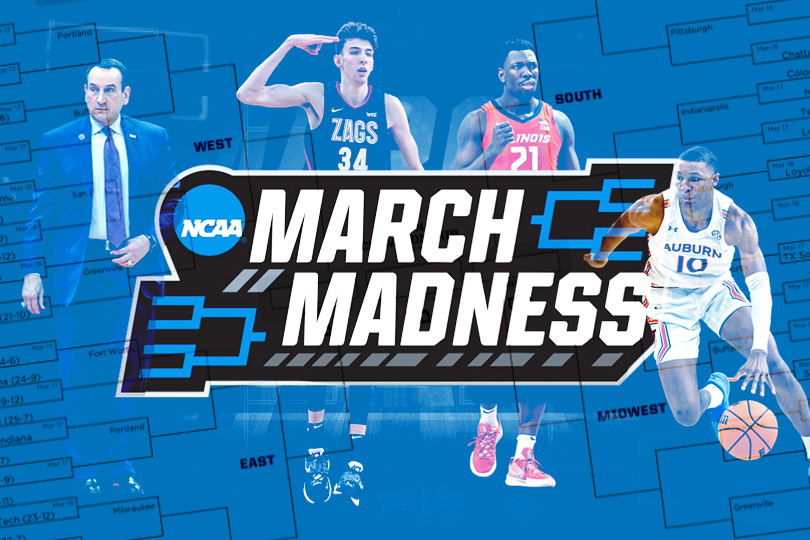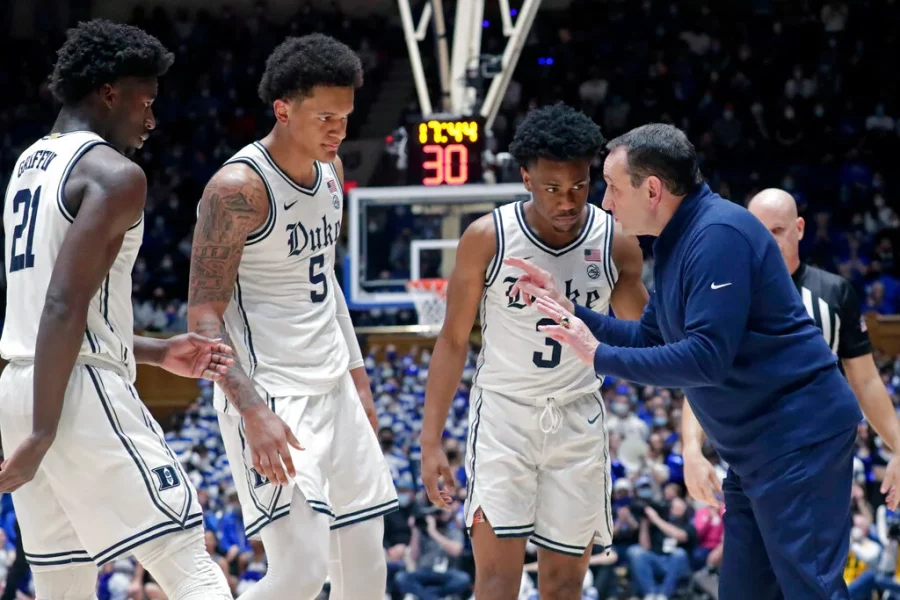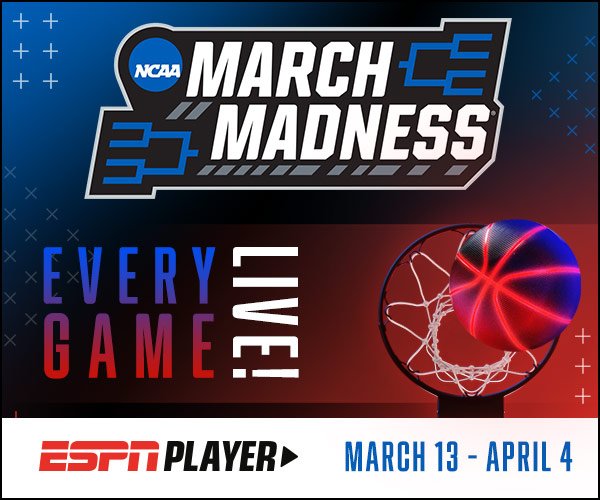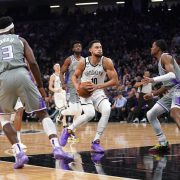
After two painful years, marked by a 2020 edition cancelled because of the Covid-19 pandemic and a 2021 edition that took place in empty halls, the “March Madness” marks its return to normality this year, with full halls all over the United States.
Starting this Tuesday, March 15, 68 teams, qualified after the regular season, will compete in the final tournament of the NCAA season. The goal: to remain undefeated, round after round, to try to be crowned national champion at the end of the “Final Four”, which will take place on April 4 in New Orleans. A 2022 edition unlike any other as it marks the farewell of Mike Krzyzewski, one of the greatest coaches in basketball history.
How to qualify for the March Madness?
There are two ways to qualify for the NCAA tournament:
– The first is for 32 teams, via “auto-bids”. These are teams whose qualification is assured by their status as conference champions. Because like the NBA, the NCAA operates by conference: there are 32 in total in the first division, and there are therefore 32 conference champions automatically qualified for the final tournament. These 32 teams are crowned at the end-of-season conference tournaments, which are held around the country during the two weeks before the NCAA tournament begins. For example, Gonzaga won its eighth WCC conference title in nine years last week, making it one of the automatic qualifiers for March Madness. Duke, on the other hand, surprisingly fell to Virginia Tech.
– The second option concerns the 36 other teams, which are not conference champions and are then selected “at-large”. This is a selection method based on the judgment of a selection committee. In order to make its choices as neutrally and objectively as possible, this committee relies on the NET (“NCAA Evaluation Tool”), an analytical tool that takes into account various criteria that make up a team’s season. The main criteria are the difficulty of the schedule and the conference in which a team is playing, the various injuries during its season, or the quality of its major wins (and losses, of course). In this way, the committee establishes a ranking, and then defines the 36 teams that will join the 32 conference champions already qualified.
In total, 68 teams ( “Field of 68”) are selected to participate in the NCAA tournament (the “First Four” being included in the tournament).
First Stage: The First Four
Before the first round, called “Round of 64” (March 17 and 18), there is the traditional “First Four” (March 15 and 16). This is simply a playoff round to determine the last four teams to qualify for the tournament. A total of eight teams take part in the play-offs: the four lowest-ranked teams from the auto-bids and the four lowest-ranked teams from the at-large. The four winners are drafted into the final bracket and the 64-team tournament can begin.
A recent example that it is possible to go far by going through this playoff phase: UCLA last year. The Bruins had a fantastic run throughout the tournament, reaching the Final Four. In the semifinals against Gonzaga, they came close but lost to an incredible buzzer-beater from midcourt by Jalen Suggs.
THE FAVORITES
Arizona (31-3). In his first season as head coach, Tommy Lloyd (assistant at Gonzaga from 2001-2021) worked miracles with the Wildcats. With a polished offensive game, executed by a squad with an international accent (Canada, Estonia, Lithuania, Cameroon and… France!), with Canadian Bennedict Mathurin at the top of the list (17.4 points, 5.6 rebounds, 2.6 assists), the program has established itself as one of the best teams in the country. Arizona flew through the PAC-12 Conference (18-2), winning the conference tournament at the expense of UCLA, and thus enters the NCAA Tournament with big odds.
Gonzaga (26-3). Undefeated last year before a tough loss to Baylor in the final, the Bulldogs are still among the favorites to win this season. Led by star freshman Chet Holmgren, expected to be in the Top 5, and by its veterans (Drew Timme, Anton Watson, Andrew Nembhard), Mark Few’s squad has delivered another authoritative WCC season (13-1), with an 8th conference title in 9 years and a new easy qualification for the March Madness. Barring any major surprises, the Bulldogs will most likely be back in New Orleans for the Final Four.
Kansas (28-6). The Jayhawks have a strong case to make. The best team in the Big-12 (14-4), Bill Self’s team has the resume of a potential finalist after a season that was mastered from start to finish, culminating in a conference title. The Jayhawks have lost some key games to other big names this season (Kentucky, Texas Tech, Baylor), but their offensive and defensive solidity is not in question. Especially since Kansas has one of the best players in the country in Ochai Agbaji, who has experience in the toughest games.

Kentucky (26-7). After a nightmarish 2020/21, Kentucky has returned to its usual standards this season: a solid 3rd place in the SEC (14-4), convincing wins (against North Carolina, Kansas or Tennessee), an unbeaten home record (18-0), and a player who has blown up everything in his path in the person of Oscar Tshiebwe, one of the favourites for the best player of the season award. The only downside is the regular physical problems of Tyty Washington Jr. and Sahvir Wheeler, the two starting backs who spearhead Kentucky’s attack. With just a few hours to go before the tournament begins, they are fully recovered from their various injuries, and the Wildcats will need that to remain the case if they hope to go all the way.
THE OUTSIDERS
Baylor (26-6). The defending champion is still around! Despite the departure of key players (Mark Vital, Davion Mitchell and Jared Butler) last year, the Bears have remained in the upper echelons of the NCAA standings, thanks to regular contributions from freshmen Kendall Brown and Jeremy Sochan, as well as seniors Flo Thamba, Adam Flager and Matthew Mayer, and former Georgetown point guard James Akinjo. Despite a few questionable losses, including to Alabama and Oklahoma State, Baylor has once again reigned supreme in the Big-12 (14-4) and enters the NCAA Tournament in an interesting position: that of the defending champion who is not a favorite, but has nothing to lose.
Duke (28-6). The Blue Devils are back on top. After a failed 2020/21 season, concluded by a non-qualification to the NCAA tournament, Duke has been solid all year long, for the last one of Coach K. Headlining the team was of course the excellent “freshman” Paolo Banchero, one of the future Top 5 drafts, who has amazed all season long with his already NBA-ready game. Even if some losses to much weaker opponents are noteworthy (Virginia, Miami), the same is true for the benchmark wins: Kentucky and Gonzaga fell to the Blue Devils. And despite the double disappointment at the end of the season (losing to rival North Carolina in Duke’s final regular season game, then losing in the conference tournament final to Virginia Tech), Duke has emerged as the ACC conference leader, and heads into March Madness with clear ambitions: in Coach K’s final season, only a 6th national championship for the iconic coach would be an acceptable outcome.

Auburn (27-5). Bruce Pearl’s team had an excellent season in the SEC (15-3), led by freshman Jabari Smith, a potential candidate for the first pick of the 2022 Draft, and whose partnership with Walker Kessler did a lot of damage in the paint. Veterans Wendell Green Jr. and KD Johnson are no strangers to Auburn’s success this season either. Although sometimes too dependent on Smith’s offensive talent, the Tigers compensate with a ruthless defense, thanks in part to Walker Kessler’s iron curtain in front of the rim (4.5 assists). Their presence in the “Final Four” is absolutely possible.
Wisconsin (24-7). The Badgers were eliminated by the future champion Baylor in the second round last year, but they have the weapons to go much further this season. Led by the excellent Johnny Davis, voted best player of the season in the Big Ten conference and who will be back on the NBA floor in a few months, the 2015 finalist is perfectly capable of reaching this stage of the tournament again this year. Dominant in their conference (15-5, 1st), considered fairly unanimously as the best in the country, the Badgers approach the March Madness on a very good momentum. Wisconsin is the scary underdog.
Purdue (27-7). Like Wisconsin, the underdog outfit that no one can face in the tournament fits Purdue perfectly. Led by the electrifying Jaden Ivey, who is destined for a top lottery pick this June and who forms a lethal pick-and-roll duo with Canadian giant Zach Edey, the Boilermakers are an attacking team whose quality of execution is perhaps unmatched in the country. In the context of the NCAA Tournament, where every possession counts, when the offensive pace often tends to slow down to ensure clean shots, this could make them even more dangerous. On the other hand, there are doubts about their ability to raise their level of play on defense during the tournament’s breathless endgame.
10 PLAYERS TO WATCH

Johnny Davis (Wisconsin – 20 points, 8.1 rebounds, 2.2 assists). Fresh off his Big Ten Conference MVP award, Wisconsin’s star guard will be one of the attractions at March Madness. Little used last year during his freshman season, he is this year the one on which the success of the Badgers rests. Wisconsin will live and die by Johnny Davis’ level of play, as evidenced by the surprise loss to Michigan State in the Big Ten Conference Tournament last week, in which the Badgers were unable to make a difference on offense, while their star back was struggling (3/19). If Johnny Davis goes, so will Wisconsin.
Jaden Ivey (Purdue – 17.2 points, 4.7 rebounds, 3 assists). Hard to find a more electrifying player than Jaden Ivey this season. Spearheading the Boilermakers’ offense, the guard has dazzled the college circuit with his phenomenal athletic ability. After going out in the first round of the tournament with Purdue last year, he will have to do better this year, for his last college games before the big jump to the NBA this summer. A complete attacker, capable of finishing in the circle as well as punishing from afar if the defense is lax, a smart passer on pick-and-roll even though he is not a true point guard, and a tough defender, he will be the heart and lungs of his team during the coming weeks.
Paolo Banchero (Duke – 17.1 points, 7.7 rebounds, 3.1 assists). Like many other freshman before him, Paolo Banchero will try to take the Blue Devils as far as possible in the NCAA tournament, the last of Coach K’s career, before joining the NBA in a few months. Dominating without much resistance in a weak ACC conference, he especially made his mark in Duke’s wins over Kentucky and Gonzaga earlier this season, during which he proved he can shine in high-stakes games where pressure and expectations are high. Of course, the NCAA Tournament is a whole different ballgame, but the strong forward has the talent to raise his game, and the shoulders to carry Duke through the rounds.
Jabari Smith (Auburn – 17.1 points, 6.9 rebounds, 1.8 assists). Offensive leader of an Auburn team that has mostly shined on defense this season, the “freshman”, for his first (and last) NCAA tournament, will have his work cut out. Because if Auburn is above all an excellent team, it is still often the talent of Smith’s attack that made the difference at the end of the game for the Tigers. Facing defenses that he is not familiar with, since he is used to SEC teams, it will be interesting to observe his adaptation during the tournament.
Oscar Tshiebwe (Kentucky – 17.3 points, 15.3 rebounds, 1.1 assists). Favourite in the race for the NCAA Player of the Year award, the Congolese pivot had an absolutely exceptional season. Author of 27 double-doubles, the all-time record of the Kentucky program, he crushed, week after week, the opposing defenses, as evidenced by his 17 points and 15 rebounds average. While the Wildcats’ success this season has been based on a collective, where danger on offense can come from anywhere, Tshiebwe will undoubtedly be the anchor for John Calipari during the tournament. If the pivot plays at the same level as during the regular season, Kentucky can comfortably aim for the Final Four.
Ochai Agbaji (Kansas – 19.8 points, 5.2 rebounds, 1.7 assists). Voted the Big-12 Conference’s best player of the season, the Kansas senior guard can finish his college career on a high note. For the Jayhawks are serious Final Four contenders, and Agbaji is the main reason why. He has the talent to carry his team through the tournament, but more importantly, the experience in pressure games. In his wake, Kansas can dream of cutting down the nets in New Orleans.
Johnny Juzang (UCLA – 16.7 points, 4.7 rebounds, 1.8 assists). Leader of a heroic Bruins team during the 2021 NCAA tournament, the guard was close to entering the draft last summer, but finally decided to come back for a third season at the university. He did well because his progression continued this season. Reliable attacker, especially at mid-range, he should easily make some cards during the tournament. Above all, he has gained experience since the crazy adventure of March 2021, and the Bruins can try to capitalize on it. Because if UCLA seems this season, on paper, a little short to return to the Final Four in view of the competition, hope is still allowed, March madness obliges, if Juzang repeats his exploits of last year.
Kofi Cockburn (Illinois – 21 points, 10.6 rebounds, 0.8 assist). The undisputed leader of the Fighting Illini this season, after the departure of Ayo Dosunmu to the NBA, the Illinois pivot, double-double machine and perhaps the most dominant player on the college circuit, will be at the forefront of the NCAA tournament. His individual form will determine the success of Illinois, which can’t survive the tournament for long without a Cockburn in overdrive. The good news is that few, if any, teams in the country have the defensive weapons to stop the massive Cockburn. But the Jamaican pivot won’t be able to do it all by himself.
Chet Holmgren (Gonzaga – 14.2 points, 9.6 rebounds, 1.8 assists). After Jalen Suggs last year, Chet Holmgren is Gonzaga’s new freshman who will try to lead his team to the title before joining the professionals. Author of a season close to a double-double, the long inside player will have the luxury of not being constantly in the forefront during the tournament. Because Gonzaga is above all a collective carried by veterans, Drew Timme in the lead, and the “freshman” is only grafting to it, bringing his qualities of outside shot and elite circle protector. But since he is one of the contenders for the first pick of the next draft, he will naturally be scrutinized from all sides: March Madness is the best environment to really judge what kind of wood such an important talent is made of.
Keegan Murray (Iowa – 23.3 points, 8.6 rebounds, 1.3 assists). The worthy successor of Luka Garza. Left for the NBA last summer after four seasons at Iowa, including a last one with a player of the year award, the pivot was replaced by Keegan Murray at the head of the Hawkeyes’ offense. A “Sophomore” this season, the winger has skyrocketed in value with NBA franchises, so much so that his place in the Top 10 of the 2022 Draft seems assured. A true serial scorer, he finished the regular season very strong, leading Iowa to the Big Ten Conference Tournament title, and enters March Madness with excellent momentum. He may be the hottest player in the country right now.
Mentions: Bennedict Mathurin (Arizona), JD Notae (Arkansas), Tari Eason (LSU), Tyty Washington Jr. (Kentucky), Tevin Brown (Murray State), Lee Hyun-jung (Davidson), Kennedy Chandler (Tennessee), Caleb Houstan (Michigan), Kameron McGusty (Miami), Collin Gillespie (Villanova)
THE SCHEDULE
First Four (March 15-16): UD Arena (Dayton, Ohio)
First Round (March 17 & 18) and Second Round (March 19 & 20 ): KeyBank Center (Buffalo, New York) , Gainsbridge Fieldhouse (Indianapolis, Indiana), Dickies Arena (Fort Worth, Texas), Moda Center (Portland, Oregon), Bon Secours Wellness Arena (Greenville, South Carolina), Fiserv Forum (Milwaukee, Wisconsin), PPG Paints Arena (Pittsburgh, Pennsylvania), Viejas Arena (San Diego, California)
Sweet 16 (March 24-25) and Elite Eight (March 26-27): AT&T Center (San Antonio, Texas), Chase Center (San Francisco, California), United Center (Chicago, Illinois), Wells Fargo Center (Philadelphia, Pennsylvania).
Final Four (semifinals April 2, national finals April 4): Caesars Superdome (New Orleans, Louisiana)
THE BRACKET

The operation of a bracket is fairly intuitive. There are four regions: West, East, South and Midwest. In each region, there are 16 teams, ranked from 1 to 16 by the selection committee, mentioned above.
In the first round, the 1st team plays the 16th team, the 2nd team plays the 15th team, the 3rd team plays the 14th team, etc. The matches then follow their course in each region. The second round corresponds to the quarter-final of each region (only 8 teams per region are left), the “Sweet 16” corresponds to the semi-final of each region (only 4 teams per region are left), and finally the “Elite 8” corresponds to the final of each region (the two finalists of the region play each other).
Then, for each of the 4 regions, the winner of the “Elite 8”, who is the champion of his respective region, joins the final four: it is the “Final Four”, that is to say the two semi-finals (then the regional final) between the 4 regional champions.
For example, last year’s Final Four consisted of Gonzaga (West Region winner), UCLA (East Region winner), Baylor (South Region winner) and Houston (Midwest Region winner). Gonzaga had beaten UCLA, and Baylor had beaten Houston. Then, in the regional final, Baylor won the title over Gonzaga.
HOW TO FOLLOW MARCH MADNESS?
BeIN Sports will now broadcast 20 games from the March Madness, including the entire Final Four live in its entirety, as well as the Grand Final.
To follow all the games (67 in total), you will have to register on the ESPN Player: https://bit.ly/ESPNBasketUSA
– ESPN Player will broadcast all 67 games of the March Madness, including the Final Four and Finals
– Tune in to ESPN Player to follow the entire March Madness from March 15 to April 4 via this link https://bit.ly/ESPNBasketUSA
– ESPN Player is only available in English
– Terms and conditions apply

 16 May
16 May 16 May
16 May 10 May
10 May 18 Apr
18 Apr 29 Mar
29 Mar 1 Dec
1 Dec 1 Dec
1 Dec 28 Nov
28 Nov 28 Nov
28 Nov 28 Nov
28 Nov 27 Nov
27 Nov 27 Nov
27 Nov 27 Nov
27 Nov 27 Nov
27 Nov 19 Nov
19 Nov 19 Nov
19 Nov 17 Nov
17 Nov 17 Nov
17 Nov 17 Nov
17 Nov 16 Nov
16 Nov